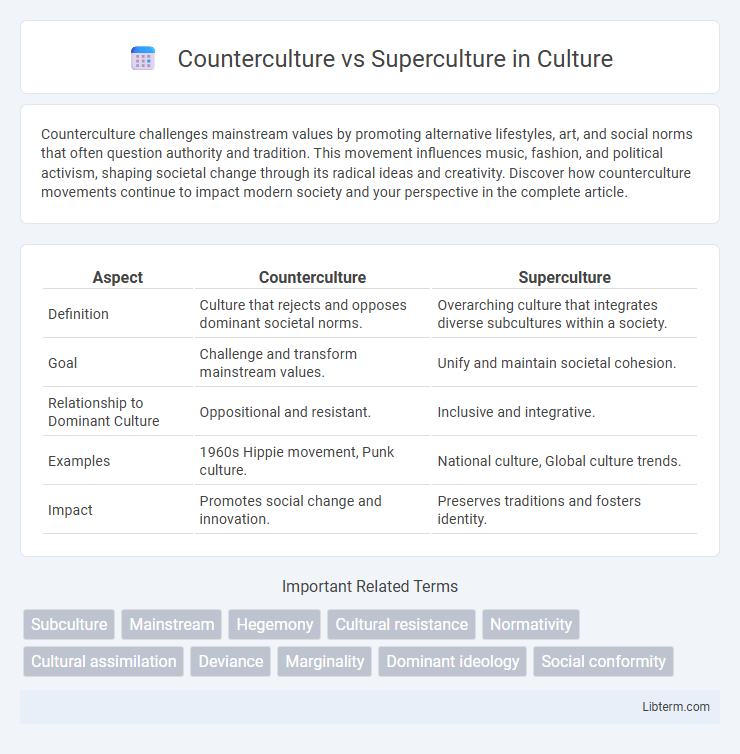Counterculture challenges mainstream values by promoting alternative lifestyles, art, and social norms that often question authority and tradition. This movement influences music, fashion, and political activism, shaping societal change through its radical ideas and creativity. Discover how counterculture movements continue to impact modern society and your perspective in the complete article.
Table of Comparison
| Aspect | Counterculture | Superculture |
|---|---|---|
| Definition | Culture that rejects and opposes dominant societal norms. | Overarching culture that integrates diverse subcultures within a society. |
| Goal | Challenge and transform mainstream values. | Unify and maintain societal cohesion. |
| Relationship to Dominant Culture | Oppositional and resistant. | Inclusive and integrative. |
| Examples | 1960s Hippie movement, Punk culture. | National culture, Global culture trends. |
| Impact | Promotes social change and innovation. | Preserves traditions and fosters identity. |
Defining Counterculture and Superculture
Counterculture represents a social group that actively rejects and opposes the dominant cultural norms, values, and ideologies of a society, often promoting alternative lifestyles and beliefs. Superculture refers to the overarching cultural framework that encompasses and unifies diverse subcultures, establishing shared norms, language, and practices within a large population. Understanding the dynamics between counterculture and superculture highlights the tension between conformity and resistance in shaping social identity and cultural evolution.
Historical Roots of Counterculture Movements
Counterculture movements have their historical roots in the social and political upheavals of the 1960s, marked by opposition to mainstream values embedded in the superculture, which represents dominant societal norms. Influenced by the civil rights movement, anti-Vietnam War protests, and the rise of the hippie subculture, countercultures emerged as expressions of resistance against established institutions and conventional lifestyles. These movements often drew inspiration from earlier historical events such as the Beat Generation of the 1950s, reflecting a persistent undercurrent of dissent challenging the superculture's hegemonic control.
Key Characteristics of Superculture
Superculture embodies dominant societal values, norms, and institutions that shape collective identity and govern social behavior on a large scale. It integrates diverse subcultures through shared language, rituals, and symbols, promoting unity and continuity across generations. This hierarchical framework often prioritizes economic and political power structures, reinforcing mainstream ideologies and cultural practices.
Major Differences Between Counterculture and Superculture
Counterculture challenges the dominant societal norms by actively rejecting and opposing mainstream values, while superculture represents the overarching cultural framework that integrates diverse subcultures under a unified set of beliefs and practices. Countercultures often arise as a form of social resistance and promote alternative lifestyles, whereas superculture facilitates social cohesion by maintaining continuity and shared identity across various groups. The major difference lies in counterculture's oppositional stance versus superculture's role in cultural integration and stability.
Influential Counterculture Movements Worldwide
Influential counterculture movements worldwide, such as the 1960s Hippie movement in the United States, the French May 1968 protests, and the anti-Apartheid struggle in South Africa, challenged dominant superculture norms by promoting peace, civil rights, and social justice. These movements often emphasized alternative lifestyles, political activism, and cultural innovation, profoundly impacting music, fashion, and societal attitudes. The tension between counterculture and superculture fosters social change by questioning established power structures and encouraging diversity in thought and expression.
The Role of Superculture in Shaping Societies
Superculture serves as the dominant framework that influences societal norms, values, and institutions, shaping collective identity and social cohesion. It integrates diverse cultural elements, providing stability and continuity while guiding behavior and decision-making processes. This overarching cultural system often absorbs or marginalizes countercultures, maintaining social order and facilitating the evolution of civilizations.
How Countercultures Challenge Mainstream Norms
Countercultures challenge mainstream norms by actively rejecting dominant societal values, often promoting alternative lifestyles and beliefs. These groups create distinct identities through unique symbols, language, and practices that oppose conventional cultural standards. Their resistance stimulates social change by questioning established power structures and fostering diverse perspectives.
Interactions and Clashes: Counterculture vs Superculture
Counterculture challenges superculture by rejecting dominant norms, values, and institutions, often sparking social tensions and ideological conflicts. These interactions manifest in protests, alternative lifestyles, and artistic expressions that confront mainstream cultural narratives. Clashes occur as superculture attempts to assimilate or suppress countercultural movements, leading to a dynamic negotiation of cultural power and identity.
Evolution of Counterculture in the Digital Age
The evolution of counterculture in the digital age is characterized by the rapid formation and dissemination of alternative ideologies through social media platforms, enabling decentralized movements to challenge dominant superculture narratives. Digital tools facilitate the creation of virtual communities that amplify diverse voices, fostering resistance against mainstream cultural norms and promoting grassroots activism. This transformation highlights the shift from localized countercultural groups to global, interconnected networks that continuously reshape cultural dynamics.
The Future Dynamics of Counterculture and Superculture
Counterculture movements often emerge as reactive forces challenging the dominant superculture, but the future dynamics suggest increasing integration and influence of countercultural values on mainstream norms. Technological advancements and global interconnectedness accelerate the diffusion of countercultural ideas, reshaping social, political, and cultural landscapes. This evolving interplay indicates a complex synthesis where superculture adapts and incorporates elements from counterculture, fostering continuous cultural transformation.
Counterculture Infographic

 libterm.com
libterm.com